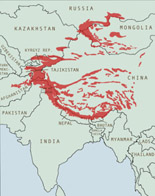Everyone is intrigued by snow leopard habitat because home for these cats is such remote and rugged locations. Snow leopard habitat covers about 2 million square kilometres in 12 countries across the majestic Himalayan Mountains and the mountains of Central Asia.
The 12 countries are Afghanistan, Bhutan, China, India, Kazakhstan, the Kyrgyz Republic, Mongolia, Nepal, Pakistan, Russia, Tajikistan and Uzbekistan. Each country, although different in culture and history, shares snow leopard habitat characteristics such as mountains with steep slopes dotted by rocky bluffs, ridges broken by outcrops, and valleys interrupted by cliffs. Snow leopards love this sort of habitat because it provides them with good cover to hide amongst rocks and cliffs when hunting. The cliffs and rocks ledges also give snow leopards protection as they merge very well into colors of rock with their beautiful camouflage fur color and rosettes. When female snow leopards have cubs cliffs provide rocky caves for birthing dens.

Mountains of Nepal, villages in snow leopard habitat. Photo by Sibylle Noras.
Most snow leopard habitat is also at very high altitudes. They live between 3000 – 4500 m (9800 – 14,800′) and sometimes hunt wild prey like argali and ibex as high as 5500 m (18,000′) in the summer. Living in these high altitudes is another reason why snow leopards are so rarely seen. It is hard work for researchers and biologists to get to these altitudes where climbing in thin air is difficult and the extreme cold can be challenging even for the very fit. Local people who live in villages in the mountains and share snow leopard habitat tend to live below 3000 meters for these reasons.
Personal snow leopard habitat.

Rocky landscape gives snow leopards cover when hunting prey in their habitat. Photo by Bishnu Devkota.
Individual snow leopards like to stay in a well-defined home range but according to researchers they don’t defend their territory aggressively when encroached upon by other snow leopards. Nor will they defend the territory against wolves. Researchers say the relationship between snow leopards and wolves is the same as cats and dogs. A snow leopard will not defend its food but will give it up to wolves in the same way a cat will usually give up to a dog. Snow leopards are generally shy, even within their own species and will only seek out other snow leopards during mating season.
Most of what we know about snow leopard habitat and the way the cats live in their habitat comes from the successful radio collar projects run by the Snow Leopard Conservancy and the Snow Leopard Trust. The studies have shown some snow leopards cover up to 30 or 40 kilometers of their habitat daily searching for prey.
Mongolia snow leopard habitat.
In Mongolia the snow leopard can be found in flat country, especially if rock ridges and ledges provide protective travel routes, and outcrops provide sufficient cover. During winter the cats will often descend to lower elevations in search of prey, but in summer they move back up the mountain to the steepest and most remote terrain. Some parts of snow leopard habitat, such as the massifs of the Gobi Desert of Mongolia are virtually devoid of vegetation.
Nepal snow leopard habitat.
In Nepal all snow leopard habitat is in the beautiful Himalayan Mountains in areas like Sagarmatha National park near Everest and Mustang in the western part of the country. Where prey is abundant, there may be between 5 to 10 cats sharing an area of 100 square km. But in regions where prey animals are scarce 5 cats would need an area of 1,000 square km to find enough prey animals to live on.
China snow leopard habitat.
China has almost 60% of the world’s snow leopard habitat in the areas like Xinjiang which is a huge, sparsely populated region of over 1.6 million square kilomteres (about one sixth of the China’s territory) and shares a border with the Tibet Autonomous Region. Other snow leopard habitat regions in China includes Qinghai and Tibet as well as Gansu, Inner Mongolia, Sichuan and Yunnan. Snow leopards occur in the mountains of Pamir, Kunlun, Altun, Tien Shan, Altai and Qilian and on the Qinghai-Tibet plateau.
Afghanistan snow leopard habitat.
Many years of war in Afghanistan have had a bad impact on snow leopard habitat in that country. Remote mountain areas have been taken over by all sides in the war with human movement in mountain areas that the cats and their prey previously had to themselves. Since 2009 however, researchers have found snow leopards in the Badakhshan Province in the northeast and camera trap evidence points to snow leopards in the Wakhan District which in 2014 was declared a National Park.
Humans sharing snow leopard habitat.

Building snow leopard proof livestock corrals where snow leopard habitat is shared with herders and their sheep. Photo by SLC in India.
One of the main reasons for the decreasing number of snow leopards in the wild is that unfortunately humans have a negative impact on the snow leopard habitat. Local people often have herds of domestic livestock driving wild sheep and goats (the snow leopard’s main prey) out of the habitat area. Sadly hunting is still an option for some local people who may not have many other ways of earning income. The main conflict however between humans and the cats in shared snow leopard habitat is when snow leopards kill village livestock and villagers will retaliate to protect their stock.






